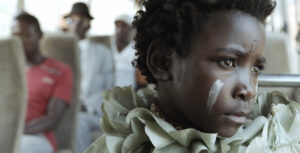I am Not a Witch employs absurdist comedy to inventively present a tale of dogma and institutional corruption.
A tourist van stops amidst sun-drenched dusty landscape. The camera stays inside the van, while the tourists get out and fascinatingly watch elderly Zambian women, sitting behind a tenuous barricade like cattle confined to pens. The women are bound with spools of ribbon. The guide remarks that these women are certified ‘witches’. And if they aren’t bound by ribbons, they would simply ‘fly away to as far as UK.’
As quickly as this deadpan declaration elicits guffaws of laughter or imparts a surrealist fantasy tone, we learn the ‘Witches camp’ is a hard reality in nations like Zambia and Ghana. Most of the old or middle-aged women in such camps are widows, denounced as witches by their family members or neighbors. These women apparently live under government protection in decrepit shacks and are used as unorganized labor force.
Nevertheless, Zambian-born Welsh filmmaker Rungano Nyoni’s directorial debut I am Not a Witch (2017) isn’t an acerbic social drama or a straightforward denunciation of female subjugation. Nyoni rather employs absurdist comedy to inventively present a tale of dogma and institutional corruption. The film is not without its missteps: its arty detachment and emotionally cryptic manner doesn’t work at times.
Yet, I Am Not a Witch is a compulsive watch for its spectacular visuals and deadpan humour.
The plot revolves around a nine-year old girl (Margaret Mulubwa), a timid and uncommunicative orphan who stands accused of witchcraft. One woman from the village alleges that the girl made her fall over while carrying a bucket of water. Another man says that the girl hit him with an axe and his arm fell off. When the droll, apathetic female police officer looks at the man’s perfect arms, he adds that it was a vivid nightmare. The officer asks the girl to confirm or deny whether she is a witch. The girl stays stubbornly silent.
Upon the intervention of Banda (Henry BJ Phiri), ‘Minister of Tourism & Traditional Beliefs’, the girl is packed off to a witch camp, situated on the dusty outskirts of town. In an elaborate ceremony, a white ribbon is fastened to the girl’s back. The other end is attached to a giant spool, so she can roam freely for a certain distance. The authorities of the camp warn the girl that if she rejects her ‘witch’ status, she would be turned into a goat.
An elderly woman in the group names the girl Shula. Soon, she finds a place among the ‘witches’, spending the day working in the fields. Banda, the annoyingly inept government official, believes in Shula’s ‘gifts’ and decides to use her in picking thieves and criminals from line-ups. The scared girl, appearing in a full witch get-up, points to a guy who actually happens to have stolen something. This makes Banda to concoct a scheme to exploit Shula’s supposed gifts. The belief in witches’ power seems to be unconditional (across the nation), whether the end result is beneficial or not. Most grudging aspect of this development is the conceptualization of a tourist industry set around the dilapidated camp.
The puritanical white-colored ribbon ironically symbolizes absurd dogma and unchecked misogyny that keeps women powerless. Writer/director Nyoni often mocks the penetration of mobile phones in the community and people’s awareness of pop-culture figures (names like Rihanna, Beyonce, Kanye West are casually thrown). Hysterical TV shows, superstitious politicians, and gawking white-skinned tourists are also thrown into the mix, exposing how old and new injustices indelibly exist despite the deep westernization.
Nyoni counterpoints the one-sided blame on patriarchal system by including women characters (Charity, Banda’s wife, and a princely woman) who perpetually fuel this system. Adorned with mesmerizing symmetrical composition by cinematographer David Gallego (Embrace of the Serpent), the film is perfectly stylized in several sequences. There’s a striking use of color palette, synchronized with distinct sound tracks of Vivaldi and thrumming choral chants.
Nyoni’s handling of the farcical element is largely commendable, never letting the balderdash upend our feelings of rage against the harsh treatment to Shula. Despite these captivating elements, the film suffers tad bit from languid, uneven pace. Some of the thematic explorations outstay their welcome and turn unsubtle. At times, the strict focus on stylization & symbolization robs the film off its emotional potency. Despite the astounding final shot, the crucial moment in the climax arrives abruptly and isn’t easy to comprehend.
Still, there are enough and more brilliant touches in I Am Not a Witch that warrant a viewing. The film was funded by BFI & Film4 Productions and supported by Cannes’ Cinefondation Residency. After a warm critical response it was nominated for BAFTA (Outstanding Debut). Rungano Nyoni’s directorial effort eventually proves that these funding and nominations aren’t just tokenistic (an endeavor to tick the ‘diversity’ box), but an affirmation of an emergence of a unique voice in cinema.
Have something to share with our readers? Thoughts on a film you saw recently; an obscure piece of film trivia; or a film you just finished watching and can’t seem to get out of your head? Head over to our Submit section for details and shoot us a mail at [email protected].
Follow @flicksidem and our Facebook channel for more updates!

